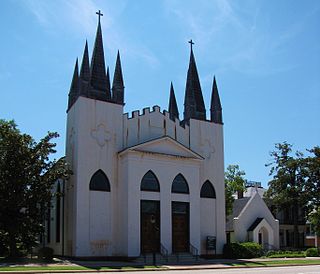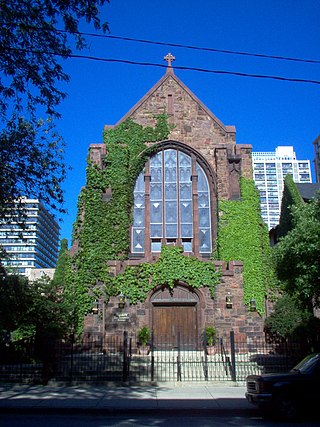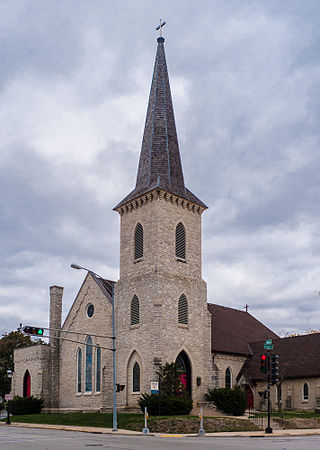
St. Stephen's Episcopal Church is a historic parish of the Episcopal Diocese of Pennsylvania, founded in 1823 in Philadelphia, Pennsylvania and located at 19 South Tenth Street, on the corner of Tenth Street and Ludlow Street. St. Stephen's was designed by William Strickland in the Gothic revival style. It is the oldest extant building in Philadelphia in this style and was designed by an architect-engineer best known for Greek Revival buildings, though, like his mentor Benjamin Latrobe, he produced buildings in other "picturesque" styles as well. St. Stephen's first service was held on February 27, 1823. On June 4, 1979, it was added to the National Register of Historic Places. On May 28, 1957, it was designated a historic landmark by the Philadelphia Historical Commission.

St. Michael's Church is a historic Episcopal church at 225 West 99th Street and Amsterdam Avenue on Manhattan's Upper West Side in New York City. The parish was founded on the present site in January 1807, at that time in the rural Bloomingdale District. The present limestone Romanesque building, the third on the site, was built in 1890–91 to designs by Robert W. Gibson and added to the National Register of Historic Places in 1996.

The Church of the Ascension and Saint Agnes is an Episcopal church building located at 1215 Massachusetts Avenue in Northwest Washington, D.C., US. The current structure built in 1874 as the Church of the Ascension was added to the National Register of Historic Places in 1984. In the late 1940s, the Church of the Ascension merged with the nearby St. Agnes Episcopal Church and adopted its present name, under which it has continued as an active parish in the Episcopal Diocese of Washington.

St. John's Episcopal Church in Fayetteville, North Carolina is a congregation of the Episcopal Diocese of East Carolina, a division of the Episcopal Church in the United States of America. Founded in 1817, it is located on Green Street in historic downtown Fayetteville. The congregation was formally organized April 7, 1817, and it became the first Episcopal church in the city. It is listed in the National Register of Historic Places. Public tours are available by appointment.

Chapel of the Cross is a parish of the Episcopal Church of the United States in Chapel Hill in the Diocese of North Carolina. It is the spiritual home to more than 1,600 communicants, including numerous students studying at the University of North Carolina at Chapel Hill.

Christ Episcopal Church is an Episcopal congregation in South Pittsburg, Tennessee, part of the Episcopal Diocese of East Tennessee. The church building and parish house, located at 302 West 3rd Street, are listed on the National Register of Historic Places.

St. Michael's AnglicanChurch is a historic church and the oldest surviving religious structure in Charleston, South Carolina. It is located at Broad and Meeting streets on one of the Four Corners of Law, and represents ecclesiastical law. It was built in the 1750s by order of the South Carolina Assembly. It is listed on the National Register of Historic Places and is a National Historic Landmark.

St. Agatha's Episcopal Church is a historic Carpenter Gothic Episcopal church located at 144 Circle Drive, in DeFuniak Springs, Florida in the United States. It is a contributing property in the DeFuniak Springs Historic District.

St. Thomas' Parish is an Episcopal church in Washington, D.C. It is part of the Diocese of Washington.

St. Paul's Church is an historic Episcopal church located near the village of Fairlee, southwest of Chestertown, Kent County, Maryland. St. Paul's Church is one of the original thirty parishes created in 1692 by an Act of the General Assembly declaring the Church of England as the established religion of the Province of Maryland. The Georgian-styled building, completed in 1713, is the second-oldest Episcopal church on the Eastern Shore of Maryland.

The Church of St. Luke and St. Matthew is a historic Episcopal church at 520 Clinton Avenue between Fulton Street and Atlantic Avenue in the Clinton Hill neighborhood of Brooklyn, New York City. This congregation was founded as St. Luke's Protestant Episcopal Church in 1842 following the failure of Trinity Church, which had been consecrated in the same building on June 1, 1835, by Bishop Onderdonk of the Diocese of Long Island. The founding of a church in this location resulted from the expansion of Brooklyn beyond initial European settlement in Brooklyn Heights. The building was constructed on a property consisting of eight city lots donated by George W. Pine.

St. John's Episcopal Church is a parish church in the Episcopal Diocese of Iowa. It is located in Keokuk, Iowa, United States. It was listed, together with the parish hall, on the National Register of Historic Places in 1989.

St. Joseph Cathedral is a Catholic cathedral located in downtown Baton Rouge, Louisiana, United States. It is the mother church of the Diocese of Baton Rouge, and it was listed on the National Register of Historic Places on March 22, 1990.

The Episcopal Church of the Atonement and Parish House is a historic church building at 5751 North Kenmore Avenue in Chicago, Illinois. The Gothic Revival building was constructed in 1889 and added to the National Register of Historic Places in 2009.

St. Matthias Episcopal Church is a Gothic Revival-styled limestone-clad church built from 1851 to 1855 in Waukesha, Wisconsin. It was built by St. Matthias parish of the Episcopal Church, now in the Diocese of Milwaukee, and is the oldest church building in Waukesha that survives basically intact.

The Church of the Holy Cross (Episcopal), which housed St. Mark's until 1954, is a historic church at 875 Cotton Street in Shreveport, Louisiana, United States. The first services of the Episcopal church in Shreveport were celebrated by the Rt. Rev. Leonidas Polk, the Bishop of Louisiana in March 1839. That liturgy is considered the founding day of St. Mark's Church. Prior to this church building, the church was located on Fannin Street. St. Mark's moved into a new church building at Fairfield Avenue and Rutherford Street in 1954. That church became the cathedral of the Diocese of Western Louisiana on July 7, 1990.

St. James's Episcopal Church is the third oldest Episcopal congregation in Richmond, Virginia. Only the older St. John's Episcopal Church on Church Hill also remains an active congregation.

All Saints Episcopal Church is an Episcopal parish located in San Leandro, California and part of the Episcopal Diocese of California. The Reverend Justin Cannon is the current Rector and Bishop Marc Andrus the overseeing bishop.

St. Paul's Episcopal Church is an Episcopal parish church located in Evansville, Indiana, within the Episcopal Diocese of Indianapolis. The parish was formally organized in 1836 after a missionary visit from Bishop Jackson Kemper. The present-day church building was erected in 1886 on the corner of 1st and Chestnut St. in downtown Evansville to replace the parish's first church built on the same site. Designed by architects James W. Reid & Merritt J. Reid, the English Gothic Revival-style structure was constructed with Bedford limestone and trimmed with Green River limestone. St. Paul's is known for being the home parish of various prominent figures in Evansville's history. It is also known for its community service, including a weekend soup kitchen through Sr. Joanna's Table.

Christ Church is an Episcopal church at 28 Bull Street, Johnson Square, in Savannah, Georgia. Founded in 1733, it was the first church established in the Province of Georgia and one of the first parishes within the Episcopal Diocese of Georgia, earning it the nickname "the Mother Church of Georgia". The present church building was constructed in 1838 and is located in the Savannah Historic District.



























